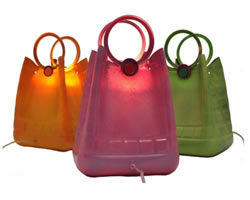Nella stanza dei bottoni / In the control room
È ipotizzabile un ruolo per architetti e designer nella gestione istituzionale dei rifiuti? Sai di esperienze del genere in Italia o in altre parti del mondo?
Do you suppose that architects and designers could have a role in the institutional management of waste? Do you know if anyone has implemented something like that, in Italy or in other parts of the world?
SB - Sinceramente non so se esista, a livello istituzionale, una figura professionale del genere, sarebbe però molto interessante. Basta considerare quali e quanti materiali vengono scartati ogni giorno, e quanti di questi materiali non possono essere riciclati. Nel mio piccolo, vedo l’entusiasmo di privati, aziende, laboratori, uffici o negozi, nel tenermi da parte i “rifiuti”. Spesso le persone, pur non sapendo che cosa fare con i materiali che scartano, sono dispiaciute nel doverli gettare o, meglio ancora, nel dovere pagare per smaltirli. Quando arrivo al kartodromo per riempire il mio furgoncino di copertoni usati mi darebbero tutto il container, visto che lo smaltimento è oneroso. E con i copertoni si possono realizzare degli oggetti molto funzionali e duraturi!
Sarebbe interessante, dicevo, se nella pubblica amministrazione, ci fosse una ruolo per architetti-designer legato alla gestione di questi scarti ancora utili. Potrebbero venire raccolti, suddivisi, catalogati e riutilizzati per la produzione di manufatti. Si potrebbe creare una sorta di magazzino di “rifiuti” riutilizzabili, collegato a un laboratorio e a uno studio di progettazione che potrebbe studiare la loro trasformazione in oggetti di design utili. Un magazzino del genere dovrebbe essere messo a disposizione di tutti, semplici cittadini, artisti o scuole.
SB - Honestly, I don’t know if a role of this kind do exist, at institutional level, but it would be very interesting.
Just consider which and how many materials are thrown away every day, and how many of these materials can’t be recycled. In my own small way, I see the enthusiasm in private citizens, companies, laboratories, offices or shops, when they store “waste” for me.
Though they don’t know what to do with the discarded materials, people are often sorry they had to throw them away and, even more, they must pay for disposal. When I arrive at the go-kart track to fill up my minivan with used tyres, they would give me the whole container. And you can make very useful and enduring objects, from tyres!
It would be interesting, as I was saying, if designer-architects played a role in the public administration, pertaining to the management of these wastes that are still useful. They could be collected, divided, classified and recycled to produce objects. A kind of reusable “waste” storehouse could be established, connected to a laboratory, and a design studio that could study their transformation into useful design objects. Something like that should be made available to everyone, mere citizens, artists, or schools.

Caffèluce lampada da appoggio
bottiglie, tappi e barattoli di plastica,
barattoli di latta
dimensioni: b 20 x 20cm – h 30cm
anno 2009